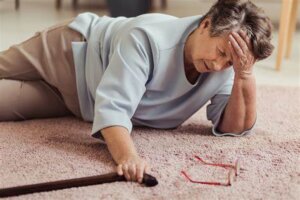Fall Risk Statistics
As you age your risk of falling at home drastically increases every year. About 25% of all adults over the age of 65 fall each year, and one out of five of those falls are fatal. Around 3 million adults are treated in emergency rooms for falls or fall related injuries in the U.S. alone. After you fall once, your chances of falling again increase by 50%. If the fall rates continue to increase the way they have been since 2007, there will be 7 deaths every hour due to falls by 2030. Those numbers are frightening to look at but luckily there are ways you can prevent accidents.
Why Do Falls Happen?
Before we get into how to prevent falls, we should know why falls occur in the first place. There are various different reasons and not all reasons apply to everyone, if you have any concerns you should voice them to your doctor. That being said here are some of the most common reasons adults over the age of 65 fall per the CDC.
- Lower body weakness
- Vitamin D deficiency (that is, not enough vitamin D in your system)
- Difficulties with walking and balance
- Use of medicines, such as tranquilizers, sedatives, or antidepressants. Even some over-the-counter medicines can affect balance and how steady you are on your feet.
- Vision problems
- Foot pain or poor footwear
- Home hazards or dangers such as broken or uneven steps, and throw rugs or clutter that can be tripped over.
Most falls are caused by a combination of risk factors. The more risk factors a person has, the greater their chances of falling.
Fall Prevention
Preventing falls can start with something as simple as changing a pair of sandals for a pair of tennis shoes. Here is a list of some of the most common ways you can prevent falls in your home.
- Nutrition and exercise- Do exercises that make your legs stronger and improve your balance. Tai Chi is a good example of this kind of exercise. Having healthy habits when it comes to diet and exercise can prevent weakness in the legs and feet, and can reduce pain.
- Minimize trip hazards- ensure you walk ways are always clear, falls tend to occur in emergencies to being unprepared. It may be time to get rid of the sandals and flipflops and get some nonslip keds or tennis shoes.
- Have your eyes examined- Have your eyes checked by an eye doctor at least once a year, and be sure to update your eyeglasses if needed. If you have bifocal or progressive lenses, you may want to get a pair of glasses with only your distance prescription for outdoor activities, such as walking. Sometimes these types of lenses can make things seem closer or farther away than they really are.
- Make your home safer- Add grab bars inside and outside your tub or shower and next to the toilet. Put railings on both sides of stairs. Make sure your home has lots of light by adding more or brighter light bulbs.
If any of this feels like it applies to you please contact your doctor. Here are a couple of pages with some more information:
Important Facts about Falls | Home and Recreational Safety | CDC Injury Center
Falls – Risk Factors and Prevention Strategies (comfortkeepers.com)
Patient & Caregiver Resources | STEADI – Older Adult Fall Prevention | CDC Injury Center